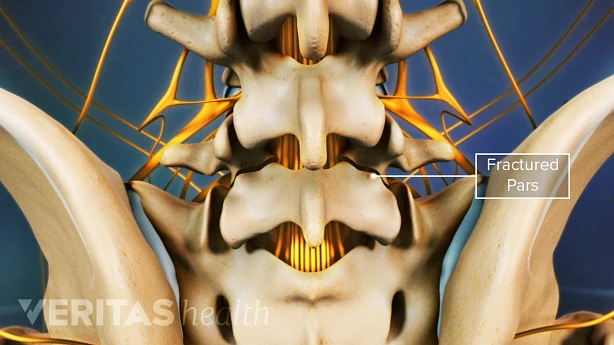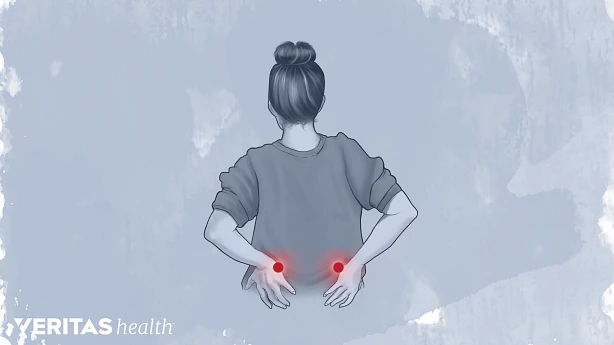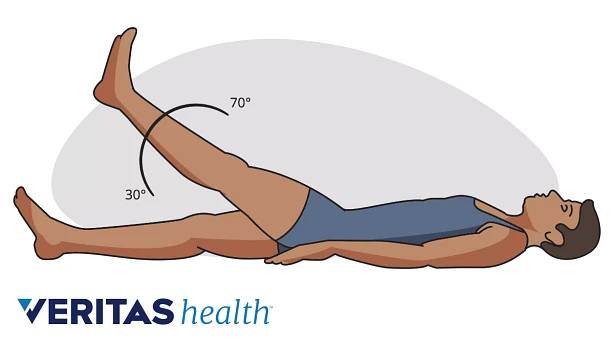About Isthmic Spondylolisthesis
Isthmic spondylolisthesis is a condition where a spinal vertebra slips forward on the one below it due to a structural defect in the small piece of bone, the pars interarticularis, which connects the two vertebrae on the back of the spine.
Isthmic spondylolisthesis can occur in the neck, upper back, or lower back, but primarily occurs in the lower back and typically doesn’t cause any symptoms. About 25% of people who have isthmic spondylolisthesis may develop symptoms, and the most common symptoms include chronic back pain with or without leg pain
About Isthmic Spondylolisthesis
Isthmic spondylolisthesis is a condition where a spinal vertebra slips forward on the one below it due to a structural defect in the small piece of bone, the pars interarticularis, which connects the two vertebrae on the back of the spine.
Isthmic spondylolisthesis can occur in the neck, upper back, or lower back, but primarily occurs in the lower back and typically doesn’t cause any symptoms. About 25% of people who have isthmic spondylolisthesis may develop symptoms, and the most common symptoms include chronic back pain with or without leg pain.
The pain can be diffuse or focal and can feel like burning, a sharp discomfort, or a dull ache. The onset may be sudden but can also develop over a more extended period and may fluctuate in severity. Some cases will resolve spontaneously without additional care, but others require corrective procedures to restore function and alleviate discomfort.
How Isthmic Spondylolisthesis Develops?

The mechanism of isthmic spondylolisthesis revolves around the integrity of a small bony bridge in the back of the spine, called the pars interarticularis. This bridge is a thin piece of bone, which connects the upper and lower facet joints on the back of each vertebra.
1. Fracture of the pars and forward displacement of the vertebra
Research shows that the pars is subjected to the greatest force compared to any other structure in the lumbar spine, making it susceptible to stress fractures. In susceptible individuals, the pars may fracture, heal, and fracture again—repeatedly.
In most cases, pars fractures are believed to be the result of repetitive motion. Other causes include trauma, or a congenital defect, weakening the structure of the pars bone.
The fracture of the pars interarticularis is known as a spondylolysis.
Over time, spondylolysis can progress, leading to the slip of one vertebra over the other—called spondylolisthesis. This slip always occurs in a forward direction and disrupts the normal alignment of the spine, causing instability and abnormal movement between the affected vertebrae.
The most commonly affected spinal segment is the L5-S1 spinal motion segment in the lower back
2. Nerve compression and pain
The degree of vertebral slippage can worsen with time, causing impingement or compression of the nearby spinal nerve roots and/or the spinal cord. This process can cause a range of symptoms, including back pain, radiating leg pain (sciatica), numbness, tingling, and muscle weakness. The severity of symptoms varies depending on the degree of slip and the structures affected.
The L5 nerve root exiting the L5-S1 spinal segment is most commonly affected by this condition.
3. Degenerative changes and compensatory mechanisms
Isthmic spondylolisthesis can also lead to degenerative changes in the affected spinal segment. The slipped vertebra increases the stress within the affected segment, leading to abnormal motion between the vertebrae. This abnormal motion can accelerate wear and tear on the intervertebral discs, facet joints, and surrounding structures. 4
As a compensatory mechanism, the body may initiate the growth of abnormal bone, called bone spurs or osteophytes, further impacting the structural integrity of the spinal segment.
How Isthmic Spondylolisthesis Develops

The mechanism of isthmic spondylolisthesis revolves around the integrity of a small bony bridge in the back of the spine, called the pars interarticularis. This bridge is a thin piece of bone, which connects the upper and lower facet joints on the back of each vertebra.
1. Fracture of the pars and forward displacement of the vertebra
Research shows that the pars is subjected to the greatest force compared to any other structure in the lumbar spine, making it susceptible to stress fractures. In susceptible individuals, the pars may fracture, heal, and fracture again—repeatedly.
In most cases, pars fractures are believed to be the result of repetitive motion. Other causes include trauma, or a congenital defect, weakening the structure of the pars bone.
The fracture of the pars interarticularis is known as a spondylolysis.
Over time, spondylolysis can progress, leading to the slip of one vertebra over the other—called spondylolisthesis. This slip always occurs in a forward direction and disrupts the normal alignment of the spine, causing instability and abnormal movement between the affected vertebrae.
The most commonly affected spinal segment is the L5-S1 spinal motion segment in the lower back
2. Nerve compression and pain
The degree of vertebral slippage can worsen with time, causing impingement or compression of the nearby spinal nerve roots and/or the spinal cord. This process can cause a range of symptoms, including back pain, radiating leg pain (sciatica), numbness, tingling, and muscle weakness. The severity of symptoms varies depending on the degree of slip and the structures affected.
The L5 nerve root exiting the L5-S1 spinal segment is most commonly affected by this condition.
3. Degenerative changes and compensatory mechanisms
Isthmic spondylolisthesis can also lead to degenerative changes in the affected spinal segment. The slipped vertebra increases the stress within the affected segment, leading to abnormal motion between the vertebrae. This abnormal motion can accelerate wear and tear on the intervertebral discs, facet joints, and surrounding structures.
As a compensatory mechanism, the body may initiate the growth of abnormal bone, called bone spurs or osteophytes, further impacting the structural integrity of the spinal segment.
Isthmic Spondylolisthesis Symptoms

The symptoms of isthmic spondylolisthesis vary depending on the severity of the condition.
The common symptoms and signs of isthmic spondylolisthesis in the lower back are described below:
Low back pain
Low back pain is the most common symptom of isthmic spondylolisthesis. The pain is usually located in the lower back and may be described as a dull ache or a sharp, stabbing pain. The pain may be worse with activity and may improve with rest.
Sciatica
Sciatica, or lumbar radiculopathy, may occur in case of nerve root irritation or compression at the affected spinal segment. Sciatica symptoms include pain that radiates down one or both legs, which is often described as a shooting or burning sensation and may be accompanied by numbness or tingling.
Muscle weakness and areas of skin numbness
Isthmic spondylolisthesis can cause weakness in the muscles of the legs and buttocks. This can make it difficult to walk or stand for long periods of time.
The skin over the thigh, leg, and/or foot may feel numb or have diminished sensations in the areas supplied by the affected spinal nerve.
Leg pain while walking
Some people may experience neurogenic claudication, or pain in both legs while walking varying distances.
Back stiffness
Some people with isthmic spondylolisthesis may experience stiffness in the lower back. This can make it difficult to bend or twist the spine.
Additionally, the posture and muscles in the back and legs may be affected, including:
Hamstring tightness. A tightness may be felt in the hamstring muscles along with a feeling of weakness or pain.
Change in the curvature of the lower spine. The “C” shaped curve of the lower back may get exaggerated, causing lordosis (increased inward curving) or swayback.
Stooped posture. Changes in the affected vertebral segment may cause balance and alignment issues, leading to a forward stooped posture.
Isthmic Spondylolisthesis Symptoms
![dr ronjon paul md (1020x681px) - how is [condition] managed? https://paulspine.com/wp-content/uploads/2021/01/dr-ronjon-paul-md-1020x681px-how-is-condition-managed.jpg](https://paulspine.com/wp-content/uploads/2021/01/Dr-Ronjon-Paul-MD-1020x681px-How-is-condition-managed.jpg)
The symptoms of isthmic spondylolisthesis vary depending on the severity of the condition.
The common symptoms and signs of isthmic spondylolisthesis in the lower back are described below:
Low back pain
Low back pain is the most common symptom of isthmic spondylolisthesis. The pain is usually located in the lower back and may be described as a dull ache or a sharp, stabbing pain. The pain may be worse with activity and may improve with rest.
Sciatica
Sciatica, or lumbar radiculopathy, may occur in case of nerve root irritation or compression at the affected spinal segment. Sciatica symptoms include pain that radiates down one or both legs, which is often described as a shooting or burning sensation and may be accompanied by numbness or tingling.
Muscle weakness and areas of skin numbness
Isthmic spondylolisthesis can cause weakness in the muscles of the legs and buttocks. This can make it difficult to walk or stand for long periods of time. The skin over the thigh, leg, and/or foot may feel numb or have diminished sensations in the areas supplied by the affected spinal nerve.
Leg pain while walking
Some people may experience neurogenic claudication, or pain in both legs while walking varying distances.
Back stiffness
Some people with isthmic spondylolisthesis may experience stiffness in the lower back. This can make it difficult to bend or twist the spine.
Additionally, the posture and muscles in the back and legs may be affected, including:
Hamstring tightness. A tightness may be felt in the hamstring muscles along with a feeling of weakness or pain.
Change in the curvature of the lower spine. The “C” shaped curve of the lower back may get exaggerated, causing lordosis (increased inward curving) or swayback.
Stooped posture. Changes in the affected vertebral segment may cause balance and alignment issues, leading to a forward stooped posture.
About Physical Therapy
Diagnosis of Isthmic Spondylolisthesis

While diagnosing isthmic spondylolisthesis, physicians check for a few classic symptoms and signs of the condition, such as :
A history of lower back pain with or without sciatica (back pain and leg pain)
A positive straight leg raise test, which includes the patient lying on his/her back and lifting one leg at a time with the other leg flat or bent at the knee. A pain encountered while lifting the affected leg usually indicates spinal nerve compression/sciatica
Pain with hyperextension, or bending backwards
Stiffness while bending the spine forward or backward
Tightness in the hamstring muscles
If isthmic spondylolisthesis is suspected, radiographic tests may be ordered. Radiographic tests for isthmic spondylolisthesis
Radiographic tests for isthmic spondylolisthesis
X-rays and/or computed tomography (CT) scans are usually considered reliable diagnostic tests to confirm isthmic spondylolisthesis and locate the accurate level of the affected vertebrae in the spine.
If nerve impingement is suspected, a magnetic resonance imaging (MRI) scan may be recommended.
Bone scan with or without single-photon emission computerized tomography (SPECT) imaging can also be helpful determining the chronicity of the condition.
Diagnosis of Isthmic Spondylolisthesis
![dr ronjon paul md (1020x681px) - how is [condition] diagnosed? https://paulspine.com/wp-content/uploads/2021/01/dr-ronjon-paul-md-1020x681px-how-is-condition-diagnosed.jpg](https://paulspine.com/wp-content/uploads/2021/01/Dr-Ronjon-Paul-MD-1020x681px-How-is-condition-diagnosed.jpg)
While diagnosing isthmic spondylolisthesis, physicians check for a few classic symptoms and signs of the condition, such as:
A history of lower back pain with or without sciatica (back pain and leg pain)
A positive straight leg raise test, which includes the patient lying on his/her back and lifting one leg at a time with the other leg flat or bent at the knee. A pain encountered while lifting the affected leg usually indicates spinal nerve compression/sciatica
Pain with hyperextension, or bending backwards
Stiffness while bending the spine forward or backward
Tightness in the hamstring muscles
Radiographic tests for isthmic spondylolisthesis
X-rays and/or computed tomography (CT) scans are usually considered reliable diagnostic tests to confirm isthmic spondylolisthesis and locate the accurate level of the affected vertebrae in the spine.
If nerve impingement is suspected, a magnetic resonance imaging (MRI) scan may be recommended.
Bone scan with or without single-photon emission computerized tomography (SPECT) imaging can also be helpful determining the chronicity of the condition.









